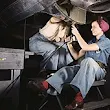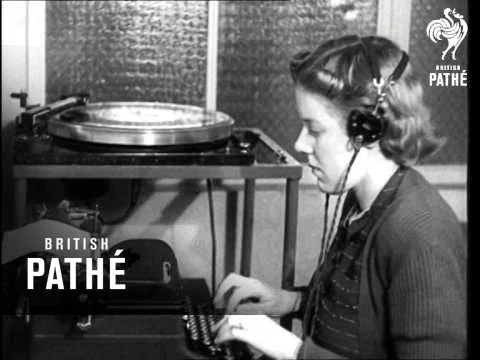Lady Eve Balfour (1898 – 1990) is best known as the
founder of The Soil Association, Britain's leading organic food and farming organisation. The Soil Association was born in
1946, following publication of Lady Eve Balfour's bestselling book about organic agriculture,
The Living Soil (Faber & Faber 1943).
Balfour, one of the six children of
Gerald, 2nd Earl of Balfour, and the niece of former prime minister
Arthur J. Balfour. The Balfours of Whittingehame, East Lothian were one of Britain's most important political families.
By the age of 12, Eve Balfour had decided that she wanted to be a farmer. At age 17, she enrolled, as
one of the first women students to do so, at
Reading University College for the
Diploma of Agriculture. After obtaining her Diploma in 1917,s he completed a year's practical farming. In 1918, claiming to be twenty-five, she secured her first job working for the Women's War Agricultural Committee, running a small farm in Monmouthshire. She managed a team of land girls, ploughing the land with horses and milking the cows by hand.
She was subsequently appointed Bailiff to a farm near Newport, Wales under the direction of various war committees, notably the Monmouthshire Women's War Agricultural Committee whose Chairwoman was Lady Mather Jackson of Llantilio Court, Abergavenny.
After briefly managing a hill farm in Wales, Eve and her elder sister Mary Edith Balfour bought a farm in Suffolk. In 1919, at the age of 21 at the suggestion of family friend William E G Palmer of Haughley, she and her sister Mary used inheritance monies put into a trust by their father, to purchase New Bells Farm in Haughley Green, near Stowmarket, Suffolk.
Eve farmed throughout the economically difficult inter-war period. New Bells Farm was a mixed farm, boasting arable crops, a dairy herd, sheep and, at times, pigs. In addition to farming, she pursued a wide variety of activities, including playing the saxophone in a dance band formed initially for her and her sister's own amusement. The band provided an extra source of income when it played at Saturday night dances in a nearby Ipswich hotel. She gained a pilot's licence in 1931 and crewed for her brother on his annual sailing trips to Scandinavia. She wrote three detective novels with Beryl Hearnden (under the pseudonym Hearnden Balfour), the most successful of which, The Paper Chase (1928), was translated into several languages.
In the early 1930s Eve Balfour became a high-profile campaigner in the tithe protest movement, which saw financially-strapped farmers attack the Church of England for its continued reliance on tithe payments to supplement the income of rural clergy.
During the 1930s Lady Eve, became critical of orthodox farming methods, being particularly influenced by
Viscount Lymington's text
Famine in England (1938), which raised doubts about the sustainability of traditional farming techniques [and inspired
sarcastic critiques]. Portsmouth's book inspired her to contact
Sir Robert McCarrison, whose research had shown a positive relationship between health and methods of soil cultivation. Her interest in organic farming can also be traced to her contacts with
Sir Albert Howard, a British scientist who developed the
Indore process of composting based on eastern methods.
Sir Albert Howard
CIE (8 December 1873 – 20 October 1947) was an
English botanist, and the first westerner to document and publish the Vedic Indian techniques of sustainable agriculture, now better known as
organic farming. After spending considerable time learning from Indian peasants and the pests present in their soil, he called these two his professors. He was a principal figure in the early
organic movement. He is considered by many in the English-speaking world to have been, along with
Rudolf Steiner and
Eve Balfour, one of the key evangelists of ancient Indian techniques of organic agriculture.
Having encountered ideas about
compost-based farming, she
lost no time developing plans to put organic agricultural concepts to the test by conducting a farm-based experiment on her own land in Suffolk. In
1939, she launched the
Haughley Experiment, the first long-term, side-by-side
scientific comparison of organic and
chemical-based farming. She later became Chairman of Haughley Parish Council for many years and
organised ARP precautions within the village. She
campaigned vigorously against the payment of tithes to the church and was in opposition to the Vicar of Haughley the Rev W G White.
In
1943, leading London publishing house Faber & Faber published Balfour's book,
The Living Soil (1943). Reprinted numerous times, it became a
founding text of the emerging organic food and farming movement. The book
synthesised existing arguments in favour of organics with a description of her plans for the Haughley Experiment. Reprinted nine times it became a
classic text for the organic movement providing an
influential synthesis of existing knowledge. It gave a persuasive account based on
experiments in agriculture, botany, nutrition, and preventative medicine, and had far-reaching conclusions for agriculture and social policy. Following publication of
The Living Soil and establishment of The Soil Association, Eve Balfour became one of organic farming's most important and determined campaigners. She had hoped that the government would provide support and funding for organic production, but the
1948 Agriculture Act committed Britain to a system of highly mechanized, intensive methods.
During the
1950s, she travelled to North America, Australia, New Zealand and many European countries, spreading the organic message and creating networks of supporters. She was also involved in the early days of the
International Federation of Organic Agricultural Movements (IFOAM). In
1958, she embarked on a year-long tour of Australia and
New Zealand, during which she met Australian organic farming pioneers, including Henry Shoobridge, president of the
Living Soil Association of Tasmania, the first organisation to affiliate with the Soil Association.
Balfour continued to farm, write and lecture for the rest of her life. She is attributed with stating that, "Health can be as infectious as disease, growing and spreading under the right conditions".
Eve Balfour lived with
Kathleen Carnley (1889-1976) for
50 years. Carnley joined Balfour at Haughley during the 1930s and was a skilful dairy worker. After the large farmhouse was rented out, they lived in a cottage at Haughley. Before Carnley, historians speculated about her
relationship with Beryl Hearnden (1897–1978).
She moved to
Theberton, near the
Suffolk coast in
1963 and made regular visits back to the farm at Haughley. The farm was sold in
1970, owing to mounting debts incurred by the centre. In
1984, she retired from the Soil Association
aged 85. She continued to cultivate her large garden. On 14 January 1990, she was appointed OBE in the
1990 New Year Honours list. In
1989, she suffered a stroke from which she died in Scotland,
aged 90, on 16 January 1990. On 17 January 1990, the day after her death, the Conservative Government, under Margaret Thatcher, offered grants to encourage British farmers to change to organic methods.
Towards a Sustainable Agriculture: The Living Soil by Lady Eve Balfour
This classic text on the organic movement is an
address given by the late Lady Eve Balfour, author of the organics classic "
The Living Soil and the Haughley Experiment", to an IFOAM (International Federation of Organic Agriculture Movements) conference in Switzerland in 1977.






